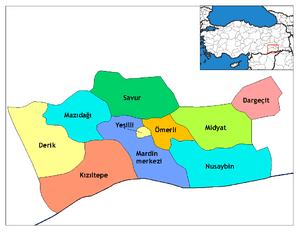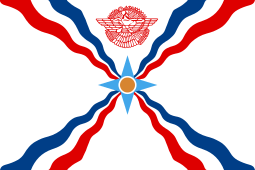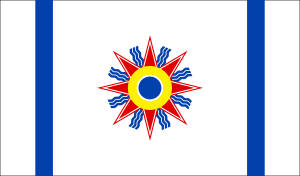Mardin
Mardin (Kurdish: Mêrdîn,[3] Ottoman Turkish: ماردين, romanized: Mārdīn, Syriac: ܡܪܕܝܢ, romanized: Mardīn[4][5]) is a city in southeastern Turkey. The capital of Mardin Province in Turkish Kurdistan, it is known for the Artuqid architecture of its old city, and for its strategic location on a rocky hill near the Tigris River that rises steeply over the flat plains.[6][7]
Mardin | |
|---|---|
The old city of Mardin | |
 Mardin Location of Mardin within Turkey. | |
| Coordinates: 37°19′0″N 40°44′16″E | |
| Country | |
| Region | Southeastern Anatolia |
| Province | Mardin |
| Government | |
| • Elected mayor | Ahmet Türk (HDP) |
| Area | |
| • District | 969.06 km2 (374.16 sq mi) |
| Elevation | 1,083 m (3,553 ft) |
| Population (2012)[2] | |
| • Urban | 86,948 |
| • District | 139,254 |
| • District density | 140/km2 (370/sq mi) |
| Time zone | UTC+3 (FET) |
| Postal code | 47x xx |
| Area code(s) | 0482 |
| Vehicle registration | 47 |
| Website | www www www |
The city has large populations of Kurds, Arabs, and Assyrians.[8] A 2013 study showed that 49% of Mardin's population identify as Arabs.[9]
History
Antiquity
The territory of Mardin and Karaca Dağ was known as Izalla in the Late Bronze Age (variously: KURAzalzi, KURAzalli, KURIzalla), and originally part of a Hurrian kingdom.
The city and its surrounds were absorbed into Assyria proper during the Middle Assyrian Empire (1365-1020 BC), and then again during the Neo Assyrian Empire (911-605 BC).[10]
The ancient name was rendered as Izalā in Old Persian, and during the Achaemenid Empire (546-332 BCE) according to the Behistun Inscription it was still regarded as an integral part of the geo-political entity of Assyria (Achaemenid Assyria, Athura).[11]
It survived into the Assyrian Christian period as the name of Mt. Izala (Izla), on which in the early 4th century AD stood the monastery of Nisibis, housing seventy monks.[12]
In the Roman period, the city itself was known as Marida (Merida),[13][14] from a Syriac/Assyrian Neo-Aramaic language name translating to "fortress".[15][16]
Between c.150 BC and 250 AD (apart from a brief Roman intervention when it became a part of Assyria (Roman province) it was part of the Neo-Assyrian kingdom of Osroene.[17]
In the late 3rd century AD Shapur II conquered Mardin and Osroene into the Sassanid Empire (224-651 AD) after which the region became part of the province of Assuristan.
Medieval history
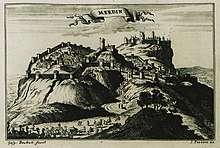
Byzantine Izala fell to the Seljuks in the 11th century. During the Artuqid period, many of Mardin's historic buildings were constructed, including several mosques, palaces, madrassas and khans. Mardin served as the capital of one of the two Artuqid branches during the 11th and 12th centuries. The lands of the Artukid dynasty fell to the Mongol invasion sometime between 1235 and 1243, but the Artuqids continued to govern as vassals of the Mongol Empire.[18] During the battle of Ain Jalut in 1260, the Artuqid governor revolted against Mongol rule. Hulagu's general and Chupan's ancestor, Koke-Ilge of the Jalayir, stormed the city and Hulegu appointed the rebel's son, al-Nasir, governor of Mardin. Although, Hulagu suspected the latter's loyalty for a while, thereafter the Artuqids remained loyal unlike nomadic Bedouin and Kurd tribes in the south western frontier. The Mongol Ilkhanids considered them important allies. For this loyalty they showed, Artuqids were given more lands in 1298 and 1304. Mardin later passed to the Aq Qoyunlu, a federation of Turkic tribes that controlled territory all the way to the Caspian Sea.
During the medieval period, the town (which retained significant Assyrian and Armenian populations) became the centre for episcopal sees of Armenian Apostolic, Armenian Catholic, Church of the East, Syriac Catholic, churches, as well as a stronghold of the Syriac Orthodox Church, whose patriarchal see was headquartered in the nearby Saffron Monastery from 1034 to 1924.[19] In 1451 the Kara Koyunlu besieged the castle of Mardin, damaging the city after their failed attempt to take the stronghold. About half a century later, in 1507, Ismail I of the Safavids succeeded to capture the city and the castle.[20]
| Year | Pop. | ±% |
|---|---|---|
| 1526 | 10,000 | — |
| 1927 | 22,249 | +122.5% |
| 1945 | 18,522 | −16.8% |
| 1950 | 19,354 | +4.5% |
| 1955 | 24,379 | +26.0% |
| 1970 | 33,740 | +38.4% |
| 1990 | 53,005 | +57.1% |
| 2000 | 65,072 | +22.8% |
| 2012 | 86,948 | +33.6% |
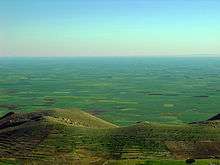
Ottoman Empire
A few years later in 1515, the city yielded to the Ottomans, who were bitter rivals of the Safavid dynasty, though the castle still remained under the control of Ismail I. One year later, the Ottomans under the leadership of Selim I besieged the city anew and eventually annexed it in 1517.[20] During this time, Mardin was administered by a governor directly appointed under the Ottoman Sultan's authority.
The city experienced a relatively tranquil period under Ottoman rule, without any significant conflicts or plights. This period of peace was finally halted when the Ottoman Empire came into conflict with the Khedivate of Egypt. During this time the city came under the rule of insurgents associated with the Milli clan. In 1835, the Milli tribe was subdued by the military troops of the Wāli of Diyarbekir Eyalet, Reşid Mehmed Pasha.[21] Between 1847 and 1865 the city's population suffered from a notable cholera epidemic, with the exact number of fatalities not known.[20] During World War I Mardin was one of the sites affected by the Armenian Genocide. On the eve of World War I, Mardin was home to over 12,000 Assyrians and over 7,500 Armenians.[22] During the armed conflicts and plights caused by the war, many were sent to the Ras al-'Ayn Camps, though some managed to escape to the Sinjar Mountain with help from local Chechens.[23] Kurds and Arabs of Mardin typically refer to these events as "fırman" (government order), while Syriacs call it "seyfo" (sword).[24] After the Armistice of Mudros Mardin was one of the Turkish cities that was not occupied by the troops of the Allied Powers.
Modern History
In 1923, with the founding of the Republic of Turkey, Mardin was made the administrative capital of a province named after it. Many Assyrian survivors of the violence later on left Mardin for nearby Qamishli in the 1940s after their conscription in the Turkish military became compulsory.[24]
Through a passed law in 2012 Mardin became a metropolitan municipality, which took office after the Turkish local elections in 2014.[25]
Ecclesiastical history
A bishopric of the Assyrian Church of the East was centred on the town when it was part of the Roman province of Assyria. It was a suffragan see of [Edessa], the provincial [metropolitan see].
It eventually became part of the Catholic Church in the late 17th century AD following a breakaway from the Assyrian Church, and is the (nominal) seat of three sees of the Catholic Church : the current Chaldean Catholic Eparchy of Mardin and two (now) titular sees under the ancient name of the town :[26] former Armenian Catholic Archeparchy of Mardin, now Titular see of Mardin only, and former Syriac Catholic Eparchy of Mardin and Amida, now titular see (initially as mere Eparchy).
Historical landmarks
Mardin has often been considered an open-air museum due to its historical architecture. Most buildings use the beige colored limestone rock which has been mined for centuries in quarries around the area.
Churches
- Meryemana (Virgin Mary) Church- A Syriac Catholic Church, built in 1895 as the Patriarchal Church, as the Syriac Catholic see was in Mardin up until the Assyrian Genocide.[27]
- Red (Surp Kevork) Church- An Armenian Apostolic Church renovated in 2015[28][29]
- Mor Yusuf (Surp Hovsep; St Joseph) Church - An Armenian Catholic Church[27]
- Mor Behnam (Kırk Şehitler) Church - A Syriac Orthodox Church built in the name of Mor Behnam and Mort Saro, the son and daughter of a ruler; dates back to 569 AD[30]
- Mor Hirmiz Church - A Chaldean Catholic Church in Mardin- It was once the Metropolitan cathedral of the Chaldean Catholic Eparchy of Mardin, prior to it lapsing in 1941. Nevertheless, One Chaldean family remains to maintain it.[31]
- Mor Mihail Church -A Syriac Orthodox Church located on the southern edge of Mardin.
- Mor Simuni Church - A Syriac Orthodox Church with a large courtyard.[32]
- Mor Petrus and Pavlus (SS. Peter and Paul) Church - A 160 year old Assyrian Protestant Church, recently renovated.[33]
- Mor Cercis Church
- Deyrü'z-Zafaran Monastery or The Monastery of St. Ananias is 5 kilometres south east of the city. The Syriac Orthodox Saffron Monastery was founded in 493 AD and is one of the oldest monasteries in the world and the largest in Southern Turkey, alongside Mor Gabriel Monastery. From 1160 until 1932, it was the seat of the Syriac Orthodox Patriarch, until the Patriarchate relocated to the Syrian capital Damascus. The site of the monastery itself is said to have been used as a temple by sun worshipers as long ago as 2000 BC.[34][35]
Islamic monuments
Mosques
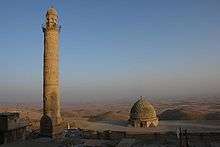
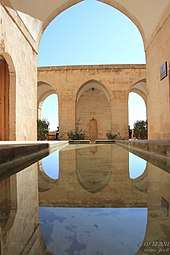
- Great Mosque (Ulu Camii) - constructed in the 12th century by the ruler of the Artukid Turks, Qutb ad-din Ilghazi. It has a ribbed dome and a minaret that soars above the city. There were originally two minarets, but one collapsed many centuries ago.
- Melik Mahmut Mosque - built in the 14th century and contains the tomb of its patron Melik Mahmut. It is known for its large gate which features elaborate stonework.
- Abdüllatif Mosque (Latfiye Mosque) - built in 1371 by the Artukid ruler Abdüllatif. Its minaret was destroyed by Tamerlane's army and rebuilt many centuries later in 1845 by the Ottoman Governor Gürcü Mehmet Pasha.
- Şehidiye Medresse and Mosque - built in 1214 by Artuk Aslan. It has an elaborate ribbed minaret and an adjoining madrassa.
- Selsel Mosque
- Necmettin Gazi Mosque
- Kasım Tuğmaner Mosque
- Reyhaniye Mosque - the second largest mosque in Mardin after Ulu Camii. Built in the 15th century, it has a large courtyard and open hallway featuring a fountain.
- Hamidiye Mosque (Zebuni Mosque) - built before the 15th century, it is named after its patron Şeyh Hamit Effendi.
- Süleymanpaşa Mosque
- Secaattin and Mehmet Mosque
- Hamza-i Kebir Mosque
- Şeyh Abdülaziz Mosque
- Melik Eminettin el-Emin Mosque
- Sıtra Zaviye Mosque
- Şeyh Salih Mosque
- Mahmut Türki Mosque
- Sarı Mosque
- Şeyh Çabuk Mosque - built in the 14th century and contains the tomb of its patron Şeyh Çabuk
- Nizamettin Begaz Mosque
- Kale Mosque
- Dinari Mosque
Madrassas
- Zinciriye Medrese (Sultan Isa Medrese) - constructed in 1385 by Najm ad-din Isa. The madrasa is part of a complex that includes a mosque and the tomb of Najm ad-din Isa.
- Sitti Radviyye Medrese (Hatuniye Medrese) - built in the 12th century in the honor of Sitti Radviyye, the wife of Najm ad-din Alpi. There is a footprint that is claimed to be that to be that of the Prophet Muhammad.
- Kasımiye Medrese - construction started by the Artuqids and completed by the Aq Qoyunlu under Sultan Kasım. It has an adjoining Mosque and a Dervish lodge.
Politics
In the 2014 local elections, Ahmet Türk of the Democratic Regions Party (DBP)[36] was elected mayor of Mardin. However, on 21 November 2016 he was detained on terror charges after being dismissed from his post by Turkish authorities. A trustee was appointed as mayor instead.[37] In the Municipal elections in March 2019 he was re-elected. He was dismissed from his post in August 2019, accused of supporting terrorism.[38] Mustafa Yaman, the Governor of Mardin Province was appointed as acting mayor.[39]
Geology
During the late Permian ~250 mya the Afro-Arabian plate started opening up. The East African continental rift initiation is believed to have started around 27-31 million years ago with the beginning of the basaltic volcanism of the Afar Plume. This rift system would cause a contractional tectonic process to occur in which the Arabian Plate was pushed in a north-easterly direction towards the Eurasian plate. The divergence in the East African Rift would eventually cause the closure of the Tethys Ocean as the Arabian Plate made its first inception of collision with Eurasia between 25-23 million years ago, and complete closure around 10 mya and creation of the Mardin High.
Climate
Mardin has a hot-summer Mediterranean climate with hot, dry summers and cold, wet, and occasionally snowy winters. Temperatures in summer usually increase to 40 °C (104 °F) due to Mardin being situated right next to the border of Syria. Snowfall is quite common between the months of December and March, snowing for a week or two. Mardin has over 3000 hours of sun per year. The highest recorded temperature is 42.5 °C (108.5 °F). Average rainfall is about 641.4 mm (25 inches) per year.
Mardin-Kızıltepe, with +48.8 °C (119.84 °F) on August 14, 1993, holds the record for the highest temperature ever recorded in Turkey.[41]
| Climate data for Mardin | |||||||||||||
|---|---|---|---|---|---|---|---|---|---|---|---|---|---|
| Month | Jan | Feb | Mar | Apr | May | Jun | Jul | Aug | Sep | Oct | Nov | Dec | Year |
| Average high °C (°F) | 7.4 (45.3) |
9.4 (48.9) |
14.5 (58.1) |
19.6 (67.3) |
26.4 (79.5) |
33.0 (91.4) |
38.1 (100.6) |
37.5 (99.5) |
33.8 (92.8) |
25.6 (78.1) |
17.1 (62.8) |
10.1 (50.2) |
22.7 (72.9) |
| Daily mean °C (°F) | 3.5 (38.3) |
4.9 (40.8) |
8.7 (47.7) |
14.4 (57.9) |
19.8 (67.6) |
25.4 (77.7) |
30.2 (86.4) |
29.6 (85.3) |
25.7 (78.3) |
18.7 (65.7) |
11.2 (52.2) |
5.0 (41.0) |
16.4 (61.6) |
| Average low °C (°F) | −0.5 (31.1) |
0.4 (32.7) |
3.5 (38.3) |
8.3 (46.9) |
13.1 (55.6) |
18.2 (64.8) |
22.3 (72.1) |
21.6 (70.9) |
17.1 (62.8) |
11.3 (52.3) |
6.2 (43.2) |
1.2 (34.2) |
10.2 (50.4) |
| Average precipitation mm (inches) | 99.8 (3.93) |
110.7 (4.36) |
94.6 (3.72) |
75.5 (2.97) |
37.7 (1.48) |
8.3 (0.33) |
3.3 (0.13) |
1.2 (0.05) |
4.1 (0.16) |
33.3 (1.31) |
68.7 (2.70) |
104.2 (4.10) |
641.4 (25.24) |
| Average rainy days | 10.6 | 10.6 | 10.7 | 9.9 | 6.6 | 1.7 | 0.5 | 0.2 | 0.7 | 5.3 | 7.4 | 10.2 | 74.4 |
| Mean monthly sunshine hours | 139.5 | 142.8 | 189.1 | 222 | 310 | 375 | 396.8 | 368.9 | 315 | 238.7 | 174 | 136.4 | 3,008.2 |
| Source: Devlet Meteoroloji İşleri Genel Müdürlüğü[42] | |||||||||||||
Notable locals
- Nabia Abbott 1897-1981, scholar of early Islam, papyrologist and paleographer
- Februniye Akyol, Syriac Co-Mayor of Mardin (2014-2016)
- Zeynel Abidin Erdem, businessman
- Muammer Güler, governor
- Malak Karsh, photographer
- Yousuf Karsh, photographer
- Sultan Kösen, the world's tallest living man since 2009.[44]
- Ignatius Maloyan (1869 - 1915), Armenian Catholic Archbishop, Christian martyr
- Murathan Mungan, poet and writer
- Aziz Sancar, scientist, 2015 Nobel prize winner in Chemistry
- Mümtaz Tahincioğlu, head of TOMSFED
- Bülent Tekin, poet and writer
- Masum Türker, former Minister of Finance
International relations
See also
- Amaseia
- Artuklu, Mardin
- Cappadocia
- Mardin (Chaldean Diocese)
- Mardin Province
- Maride
- Turabdin
- Ürgüp
- Yazidis in Turkey
References
- "Area of regions (including lakes), km²". Regional Statistics Database. Turkish Statistical Institute. 2002. Retrieved 2013-03-05.
- "Population of province/district centers and towns/villages by districts - 2012". Address Based Population Registration System (ABPRS) Database. Turkish Statistical Institute. Retrieved 2013-02-27.
- Avcýkýran, Dr. Adem (ed.). "Kürtçe Anamnez, Anamneza bi Kurmancî" (PDF). Tirsik. p. 55. Retrieved 17 December 2019.
- Payne Smith, Robert (1879–1901). Thesaurus Syriacus (in Latin). Oxford: Clarendon Press. 2219.
- Thomas A. Carlson et al., “Mardin — ܡܪܕܝܢ ” in The Syriac Gazetteer last modified June 30, 2014, http://syriaca.org/place/130.
- , from roughguides.com
- https://geographical.co.uk/expeditions/item/3603-a-walking-through-mardin-southeastern-turkey-s-labyrinthine-town
- Uğur Mumcu (1993). Kürt Dosyası (in Turkish). p. 71.
- Ayse Guc Isik, 2013.The Intercultural Engagement in Mardin. Australian Catholic University. p. 46.
- Parpola - Assyrians after Assyria
- Besides, in the Behistun inscription, Izalla, the region of Syria renowned for its wine, is assigned to Athura. George Roux - Ancient Iraq
- Johann Elieser Theodor Wiltsch, trans. John Leitch, Handbook of the Geography and Statistics of the Church, Volume 1, Bosworth & Harrison, 1859, [books.google.ch/books?id=DbwpAAAAYAAJ&pg=PA232 p. 232.]
- "Mardin". Encyclopædia Britannica.
- Fraternité Chrétienne Sarthe-Orient, "Marida (Mardin)" Archived 2014-01-25 at the Wayback Machine
- Lipiński, Edward (2000). The Aramaeans: their ancient history, culture, religion. Peeters Publishers. p. 146. ISBN 978-90-429-0859-8.
- Smith, of R. Payne Smith. Ed. by J. Payne (1998). A compendious Syriac dictionary : founded upon the Thesaurus Syriacus (Repr. ed.). Winona Lake, Ind.: Eisenbrauns. p. 299. ISBN 978-1-57506-032-3. Retrieved 8 March 2013. suggesting Mardin as a plural "fortresses".
- Amir Harrak". Journal of Near Eastern Studies 51 (3): 209–214. 1992. doi:10.1086/373553. JSTOR 545546.
- Ed. Morris Rossabi - China among equals: the Middle Kingdom and its neighbors, 10th-14th centuries, p. 244
- Cinti Migliarini, Anita. "La chiesa siriaca di Antiochia". Chiesa siro-ortodossa di Antiochia (in Italian). Archived from the original on 13 March 2016. Retrieved 1 March 2016.
- Mehmet Taştemir. "MARDİN" (in Turkish). İslam Ansiklopedisi [Islamic Encyclopedia]. p. 45. Retrieved 29 September 2018.
- Aydın, Suavi; Verheij, Jelle (2012). Jorngerden, Joost; Verheij, Jelle (eds.). Social Relations in Ottoman Diyarbekir, 1870-1915. Brill. p. 31. ISBN 9789004225183.
- Kevorkian, Raymond (2011). The Armenian Genocide: a Complete History. London: Tauris. p. 371.
- Kevorkian, Raymond (2011). The Armenian Genocide: a Complete History. London: Tauris. pp. 375–376.
- Biner, Zerrin Özlem (Fall–Winter 2010). "Acts of Defacement, Memory of Loss: Ghostly Effects of the "Armenian Crisis" in Mardin, Southeastern Turkey". History and Memory.
- "Kanun No. 6360". resmigazete.gov.tr. Archived from the original on 15 August 2015. Retrieved 25 August 2014.
- Annuario Pontificio 2013 (Libreria Editrice, 2013, ISBN 978-88-209-9070-1), p. 923
- "Mardin - Duane Alexander Miller's Blog". Retrieved 5 July 2016.
- "Mardin Surp Kevork Kilisesi için Kitap Kermesi ve Söyleşi". Retrieved 5 July 2016.
- http://www.mardintravel.com/surp-kevork-church/
- Philandre (6 October 2013). "Sunday Service, Syriac Orthodox Church of the Forty Martyrs, Mardin, Turkey". Retrieved 5 July 2016.
- "St Hirmiz Chaldean Church in Mardin, Turkey". 2 June 2015. Retrieved 5 July 2016.
- simpsonturkishadventures.blogspot.com/2013/03/easter-in-mardin.html
- "Renovated Protestant church in Mardin to open soon". Retrieved 5 July 2016.
- SOR (2000-04-19). "Dayro d-Mor Hananyo: Erstwhile seat of the Syriac Orthodox Patriarch". Sor.cua.edu. Retrieved 2012-08-17.
- "ARTS-CULTURE - Syriac monastery dated back to 4,000 years". Hurriyetdailynews.com. 2010-01-03. Retrieved 2012-08-17.
- "The final nail in the coffin of peace process in Turkey". Al-Monitor. 22 November 2016.
- "Court arrests former Mardin mayor Ahmet Türk". Hurriyet Daily News. 24 November 2016.
- "Three pro-Kurdish mayors replaced in southeastern Turkey". Middle East Eye. Retrieved 2019-08-19.
- "Trustee Appointed to Cizre Municipality in Şırnak". Bianet. Retrieved 25 March 2020.
- Prothero, W.G. (1920). Armenia and Kurdistan. London: H.M. Stationery Office. p. 62.
- "Sıkça Sorulan Sorular - Meteoroloji Genel Müdürlüğü".
- "Archived copy". Archived from the original on 2011-01-19. Retrieved 2011-01-12.CS1 maint: archived copy as title (link)
- "Resmi İstatistikler (İllerimize Ait İstatistiki Veriler)". MGM. Archived from the original on 2015-11-09. Retrieved 2015-06-11.
- Satter, Raphael (16 September 2009). "8'1" Turk takes title of world's tallest man". Retrieved 17 September 2009.
- "Medmestno in mednarodno sodelovanje". Mestna občina Ljubljana (Ljubljana City) (in Slovenian). Archived from the original on 2013-06-26. Retrieved 2013-07-27.
Sources and external links
| Wikimedia Commons has media related to Mardin. |
| Wikivoyage has a travel guide for Mardin. |
- Mardin Guide and Photo Album
- GCatholic - former & defunct Catholic sees in present Turkey, each linking
- The Spoken Arabic of Mardin
- Mardin Weather Forecast Information
- First International Symposium of Mardin History
- Herbermann, Charles, ed. (1913). . Catholic Encyclopedia. New York: Robert Appleton Company.
- Ayliffe, Rosie, et al.. (2000) The Rough Guide to Turkey. London: Rough Guides.
- Gaunt, David: Massacres, Resistance, Protectors: Muslim-Christian Relations in Eastern Anatolia During World War I, Gorgias Press, Piscataway (NJ) 2006 I
- Grigore, George (2007), L'arabe parlé à Mardin. Monographie d'un parler arabe périphérique. Bucharest: Editura Universitatii din Bucuresti, ISBN 978-973-737-249-9[1]
- Jastrow, Otto (1969), Arabische Textproben aus Mardin und Asex, in "Zeitschrift der Deutschen Morgenländischen Gesellschaft" (ZDMG) 119 : 29–59.
- Jastrow, Otto (1992), Lehrbuch der Turoyo-Sprache in "Semitica Viva – Series Didactica", Wiesbaden : Otto Harrassowitz.
- Minorsky, V. (1991), Mārdīn, in "The Encyclopaedia of Islam". Leiden: E. J. Brill.
- Niebuhr, Carsten (1778), Reisebeschreibung, Copenhagen, II:391-8
- Shumaysani, Hasan (1987), Madinat Mardin min al-fath al-'arabi ila sanat 1515. Bayrūt: 'Ālam al-kutub.
- Tavernier, Jean-Baptiste (1692), Les six voyages, I:187
- Sasse, Hans-Jürgen (1971), Linguistische Analyse des Arabischen Dialekts der Mhallamīye in der Provinz Mardin (Südossttürkei), Berlin.
- Socin, Albert (1904), Der Arabische Dialekt von Mōsul und Märdīn, Leipzig.
- della Valle, Pietro (1843), Viaggi, Brighton, I: 515
- Wittich, Michaela (2001), Der arabische Dialekt von Azex, Wiesbaden: Harrassowitz.
- "Archived copy". Archived from the original on 2007-09-27. Retrieved 2007-05-09.CS1 maint: archived copy as title (link)
